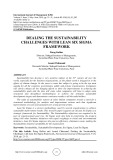
111
6
CHAPTER
10 Common
Questions about
Six Sigma
O
ur consulting organization has been associated with Six Sigma
since its inception in the 1980s. During the last 20 years, we have
heard virtually every question asked about both the concept and ap-
plication of this cutting edge management philosophy.
In our final chapter, we address 10 common questions asked
about Six Sigma and provide our insight into their answers. It
should be noted that in some cases, these questions are honest
forms of curiosity about the topic. In other cases, these questions
are forms of resistance on the part of the questioner. For purposes
of this chapter, we assume the best-case scenario about the inten-
tions behind each question.
Question #1 Isn’t Six Sigma just like other quality initiatives in the
past, almost all of which were failures?
By far, this is the most common question we hear. As we have al-
ready alluded, Six Sigma uses many of the same tools and tech-
niques as other quality initiatives, but there are huge differences
between Six Sigma and previous efforts.

112 SIX SIGMA FOR EVERYONE
First, other quality initiatives never gained the attention of
top management. Whether the quality initiative was Statistical Pro-
cess Control, Total Quality Management, Hoisin Planning, or other
quality initiatives, it was a rarity for management to actually be in-
volved. What typically happened was project teams were immedi-
ately formed among those that had an interest in improvement.
These teams attempted to utilize quality tools and techniques, but
without the support of management. Thus, the effort was half-
hearted as were the results.
Six Sigma is different because of management’s active involve-
ment. Jack Welch at General Electric said that Six Sigma was the
most important initiative he brought to General Electric in the 20
years he was at the helm. His successor, Jeffery Immelt, mentioned
expanding Six Sigma four times in his first interview with the Wall
Street Journal. The other two finalists for Jack Welch’s succession,
James McNerney and Robert Nardelli brought Six Sigma to their
new organizations (3M and Home Depot, respectively) in the first
month after leaving General Electric.
Why has Six Sigma garnered such support from such high-
level executives? Because the executives use Six Sigma strategi-
cally, as an enabler to achieving the business objectives of the
organization (see Chapter 2). With the support, encouragement,
and resource allocation of management, Six Sigma has become a
way of doing business in the organizations that embrace it, some-
thing that never happened with other quality initiatives. How
many other quality initiatives have had the support of manage-
ment like Six Sigma?
With that management support, results follow. In recent
months, our consulting firm has assisted our clients generate multi-
million dollar cost savings while improving customer satisfaction
and improving the bottom line. One financial services client re-
duced dispute resolution time for a credit card process from over
38 days to less than 3. Another client, a health care provider, re-
duced unexpected complications and improved patient registra-
tion. If something is successful, it is used. These kinds of results
attract the active involvement of management. When manage-
ment supports something, it will work. Therein lies the difference
between Six Sigma and other quality initiatives.

10 Common Questions about Six Sigma 113
Question #2 How will I know if my organization is successfully im-
plementing Six Sigma?
There are several signs you should be looking for if your organiza-
tion is becoming successful in its efforts to implement Six Sigma.
First, management in your organization will begin to become
more fact-based. Attending a meeting will result in decisions made
by data rather than the person with the loudest voice. Someone in
those meetings will ask to see the data, whether that data is a Pareto
chart, a histogram, or a survey from a customer.
Second, you will start to become more familiar with the con-
cept of process. As we described earlier in this book, a process is a
series of steps or activities that takes inputs, adds value, and pro-
duces outputs for a customer. While everyone talks about being
customer focused, only those that begin to measure, manage, and
improve the processes of their organization will truly be customer
focused. Thus, if your organization is successfully implementing
Six Sigma, you and others in your organization will become more
familiar with the processes you either work in or are affected by. In
addition, you will become aware of the key measures of effective-
ness and efficiency for those processes.
Third, you could expect to see and participate in more im-
provement teams. When an organization starts a Six Sigma initia-
tive, the first teams will appear to be a novelty. After some period
of time, improvement will become an expectation of every em-
ployee in the organization. Thus, the concept of improvement
teams and your periodic participation on them will become stan-
dard fare rather than a novelty.
Fourth, the focus of energy of a Six Sigma organization changes.
Reward and recognition migrates from the fire fighter to the arsonist
catcher. What this means is that the organization you work in will
become proactive rather than reactive.
Question #3 Isn’t Six Sigma going to rob me of my creativity?
This question has become more prevalent since National Public
Radio (NPR) ran a segment on this very topic. NPR indicated that
many employees are concerned that their creativity will be limited
by having to be in an organization that manages with facts and data.

114 SIX SIGMA FOR EVERYONE
Just the opposite will happen. Employees will have far greater
opportunity to exhibit their creativity in a Six Sigma organization.
There are two major ways that a Six Sigma culture encourages cre-
ativity rather than hampers it.
First, while on a DMAIC project team, the success or failure
of the team is directly related to how well project team members
tap into their creativity. Recognize that while decisions are made
based on data, the team enters the root causation phase of Analy-
sis with the responsibility to generate root causes through brain-
storming. This, by definition, will cause project team members to
use both their experience and creativity relative to the project.
Again, in Improve, project team members must brainstorm ideas
that will generate improvement in sigma performance. Time and
again, I have seen that teams with great ideas (that are tested and
verified) dramatically improve sigma performance.
Second, there is another tactical methodology that helps to cre-
ate new processes or products. This design for Six Sigma methodol-
ogy is known by its initials DMADV, which stands for Define,
Measure, Analyze, Design, and Verify. DMADV is used when a pro-
cess or product does not currently exist that is needed to positively
impact a strategic business objective of the organization. The cre-
ativity of DMADV project team members is pivotal toward the suc-
cess of its goals.
Therefore, whether the team is using DMAIC or DMADV, cre-
ativity is a must if the team is going to be successful.
Question #4 Will I lose my job if Six Sigma is successful?
One of the problems with a quality improvement approach years
ago called Process Re-engineering was that virtually all of the ben-
efits touted to management were workforce reductions.
The goal of Six Sigma is to improve both effectiveness and effi-
ciency. Efforts that focus exclusively on efficiency (like process re-
engineering) often can appear like a workforce reduction effort.
When efforts like Six Sigma work on effectiveness (which you will
remember is improving how well you meet your customer’s needs
and requirements) properly, it is typical for the business to grow and
expand, not contract.
You should also remember our discussion of business process
management in Chapter 2. Six Sigma should always be structured

10 Common Questions about Six Sigma 115
in a way to achieve the business objectives of the company. I
haven’t yet seen Six Sigma be exclusively devoted to just the re-
duction of employees engaged in inefficiency.
Having said that Six Sigma is not an employee reduction pro-
gram, the following also has to be said: If your job is exclusively
devoted to work around inefficiency, ultimately your job is a target
for possible change or elimination. To not acknowledge this fact
would be deceptive. If this is the case, you want to expand your
work knowledge into other areas of the business. In the best case,
as your organization improves both effectiveness and efficiency,
your skills could be used elsewhere in the organization. Addition-
ally, if your current work is focused on inefficiency, it is even more
important to work on a Six Sigma team. The skills you master as
part of a Six Sigma team will dramatically assist your career de-
velopment, whether those skills will be used in your current posi-
tion, a new position in your current organization, or some other
company.
Question #5 We have tried improvement before, why should Six
Sigma be any different?
Since the 1980s, many organizations have made half-hearted at-
tempts at improving their organization through quality. I would
be the first to say that whether the effort was Statistical Process
Control, Total Quality Management, a Just-In-Time effort, or
some other well-intentioned program, it probably failed.
Have you ever considered why it failed? I have spent consider-
able time and money studying why quality efforts have failed.
What I and others in my organization have found is that previous
efforts failed for the following reasons:
• Little or no management support and involvement.
• There was not a strategic element associated with previous
efforts.
• Management of the acceptance of other initiatives never
occurred.
Let’s briefly discuss how Six Sigma properly addresses each of
these failures. First, management historically has not been
involved in quality efforts because they didn’t see the connection













![Tối ưu hóa hiệu suất hệ thống: Bài thuyết trình [Chuẩn nhất]](https://cdn.tailieu.vn/images/document/thumbnail/2025/20251107/hiepdz2703@gmail.com/135x160/35941762488193.jpg)




![Bài giảng Quản trị chất lượng trong công nghiệp thực phẩm [chuẩn nhất]](https://cdn.tailieu.vn/images/document/thumbnail/2025/20250805/vijiraiya/135x160/637_bai-giang-quan-tri-chat-luong-trong-cong-nghiep-thuc-pham.jpg)

![Đề cương bài giảng Kỹ năng hoạt động công nghiệp [mới nhất]](https://cdn.tailieu.vn/images/document/thumbnail/2025/20250715/kimphuong1001/135x160/76971752564028.jpg)


![Bài giảng Kỹ thuật điều độ trong sản xuất và dịch vụ [mới nhất]](https://cdn.tailieu.vn/images/document/thumbnail/2025/20250630/dcbaor/135x160/13121751251866.jpg)


